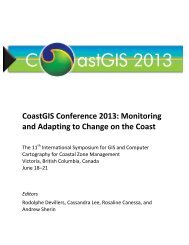in Context the SCotian Shelf - COINAtlantic
in Context the SCotian Shelf - COINAtlantic
in Context the SCotian Shelf - COINAtlantic
Create successful ePaper yourself
Turn your PDF publications into a flip-book with our unique Google optimized e-Paper software.
MARINE Tourism Governance<br />
Multiple government agencies are responsible for regulat<strong>in</strong>g mar<strong>in</strong>e tourism, with <strong>the</strong> relevant department<br />
depend<strong>in</strong>g on <strong>the</strong> type of activity undertaken.<br />
Transport Canada regulates recreational boat<strong>in</strong>g; Fisheries and Oceans Canada regulates recreational<br />
fish<strong>in</strong>g and provides guidel<strong>in</strong>es for whale watch<strong>in</strong>g. Cruise ships are required to comply with a variety of<br />
regulations, <strong>in</strong>clud<strong>in</strong>g requirements of <strong>the</strong><br />
International Maritime Organization, <strong>the</strong> Canada Border Services Agency, Transport Canada and<br />
Environment Canada. Various departments are responsible for regulat<strong>in</strong>g development <strong>in</strong> <strong>the</strong> coastal<br />
zone, such as <strong>the</strong> <strong>in</strong>frastructure support<strong>in</strong>g coastal recreational tourism.<br />
133 were non-residents, ma<strong>in</strong>ly from o<strong>the</strong>r regions<br />
<strong>in</strong> Canada. There were approximately 18 000 saltwater<br />
anglers <strong>in</strong> Nova Scotia <strong>in</strong> 1995 and nearly<br />
23 000 <strong>in</strong> 2000 (Gardner P<strong>in</strong>fold 2005); figures<br />
are not available for 2005. Key mar<strong>in</strong>e anadromous<br />
species <strong>in</strong>clude smelt, mackerel and cod.<br />
In 2000, mar<strong>in</strong>e fish<strong>in</strong>g effort constituted about<br />
22% of total recreational fish<strong>in</strong>g effort (days) <strong>in</strong><br />
<strong>the</strong> prov<strong>in</strong>ce; <strong>in</strong> 2005, saltwater fish<strong>in</strong>g was about<br />
20% of <strong>the</strong> total recreational fish<strong>in</strong>g effort (DFO<br />
2005). In 2005, Canadian anglers were estimated<br />
to spend about $762/year per angler on fish<strong>in</strong>g,<br />
an <strong>in</strong>crease of more than $100 over <strong>the</strong> 2000<br />
total (Gardner P<strong>in</strong>fold 2005, DFO 2007a). Total<br />
spend<strong>in</strong>g by Nova Scotia anglers – both mar<strong>in</strong>e<br />
and freshwater – was estimated to be $ 21.9 million<br />
(DFO 2007a). Spend<strong>in</strong>g on saltwater fish<strong>in</strong>g<br />
is typically on boats, motors, transportation and<br />
camp<strong>in</strong>g and fish<strong>in</strong>g equipment.<br />
comb<strong>in</strong>ed expenditures of $50 million <strong>in</strong> <strong>the</strong> local<br />
area (Cruise Halifax 2011b).<br />
3.4.6 Maritime Defence<br />
Canada’s naval presence on <strong>the</strong> east coast is provided<br />
through Maritime Force Atlantic (MARLANT) and<br />
has its headquarters <strong>in</strong> Halifax. The MARLANT area<br />
of responsibility covers approximately 6 million km 2<br />
and extends from <strong>the</strong> Canada-US boundary <strong>in</strong> <strong>the</strong><br />
Gulf of Ma<strong>in</strong>e to Greenland and <strong>in</strong>cludes Canada’s<br />
eastern Arctic to approximately 95 degrees west.<br />
Canada’s maritime forces engage <strong>in</strong> a range of<br />
operations and activities <strong>in</strong>clud<strong>in</strong>g sovereignty<br />
patrols, maritime surveillance, naval tra<strong>in</strong><strong>in</strong>g<br />
Economic Overview<br />
Coastal tourism <strong>in</strong> <strong>the</strong> prov<strong>in</strong>ce was estimated to<br />
generate about $300 million <strong>in</strong> expenditures <strong>in</strong><br />
2006, down from about $363 million <strong>in</strong> 2002<br />
(Gardner P<strong>in</strong>fold 2009). Coastal tourism makes<br />
up <strong>the</strong> bulk of <strong>the</strong> expenditures; <strong>the</strong>se were<br />
estimated to be about $319 million <strong>in</strong> 2002 but<br />
decl<strong>in</strong>ed to $272 million <strong>in</strong> 2006. The cruise ship<br />
<strong>in</strong>dustry also experienced a decl<strong>in</strong>e <strong>in</strong> expenditures<br />
<strong>in</strong> <strong>the</strong> middle of <strong>the</strong> decade; however, recent<br />
figures from <strong>the</strong> <strong>in</strong>dustry show that <strong>the</strong> number<br />
of passengers visit<strong>in</strong>g Halifax have largely recovered<br />
(Cruise Halifax 2011a). The Port of Halifax<br />
claims that passengers, crew and cruise l<strong>in</strong>es have<br />
2<br />
The total is based on figures available for Nova Scotia, not <strong>the</strong> Canadian average per angler.<br />
http://co<strong>in</strong>atlantic.ca/<strong>in</strong>dex.php/state-of-<strong>the</strong>-scotian-shelf<br />
47













